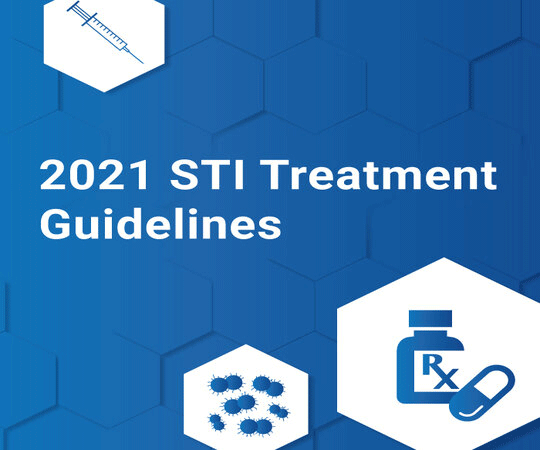CDC Releases Updated STI Treatment Guidelines
Cross-post from Centers for Disease Control and Prevention

Dear Colleagues,
CDC has released Sexually Transmitted Infections Treatment Guidelines, 2021. This document provides current evidence-based diagnostic, management, and treatment recommendations, and serves as a source of clinical guidance for managing sexually transmitted infections (STIs).
The new guidelines include notable updates from the previous 2015 guidance, including:
- Updated treatment recommendations for chlamydia, trichomoniasis, and pelvic inflammatory disease.
- Updated treatment recommendations for uncomplicated gonorrhea in neonates, children, and other specific clinical situations (e.g. proctitis, epididymitis, sexual assault), which builds on broader treatment changes published in Morbidity and Mortality Weekly Report late last year.
- Information on FDA-cleared diagnostic tests for Mycoplasma genitalium and rectal and pharyngeal chlamydia and gonorrhea.
- Expanded risk factors for syphilis testing among pregnant patients.
- Recommended two-step serologic testing for diagnosing genital herpes simplex virus.
- Harmonized recommendations for HPV vaccination with the Advisory Committee on Immunization Practices.
- Recommended universal hepatitis C testing in alignment with CDC’s 2020 hepatitis C testing recommendations.
STIs are common and costly to the nation’s health and economy. With 26 million new STIs occurring each year, totaling nearly $16 billion in medical costs, evidence-based prevention, diagnostic, and treatment recommendations are critical to halting continued increases.
The new recommendations come at a pivotal moment in our field’s history. As many of you know all too well, the COVID-19 pandemic caused decreased clinic capacity, as well as drug and diagnostic test kit shortages. Along the way, CDC provided guidance for the disruption of STD clinical services, focusing on syndromic management and STI screening approaches to maximize the number of people with STIs identified and treated, while prioritizing those most likely to experience complications. However, most drug and testing kit shortages have since resolved and many health care providers are returning to normal clinical practices, which includes conducting STI evaluation and management in accordance with the latest CDC Sexually Transmitted Infections Treatment Guidelines, 2021.
You can stay informed on the latest STI recommendations and clinical guidance with CDC’s online and print resources, which include:
- An updated wall chart and pocket guide summarizing the current treatment and screening recommendations. A limited number of free copies will be available for order through CDC-INFO On Demand in the coming weeks, as well as the MMWR itself. PDFs are available online in the meantime.
- An updated STI Treatment Guidelines mobile app is in development and is expected to launch in the coming months. NOTE: The 2015 STD Treatment Guidelines app will be retired at the end of July 2021. CDC is finalizing an interim, mobile-friendly solution – please visit STI Treatment Guidelines (cdc.gov) where we will post information, as it becomes available.
- A customizable letter is also available for colleagues looking to promote the updated guidelines.
CDC partners offer an array of additional resources. The National Network of STD Clinical Prevention Training CentersExit Disclaimer provides training and technical assistance. Providers also can access STD clinical consultation services through the latest STD Clinical Consultation NetworkExit Disclaimer.
For questions about the updated 2021 STI Treatment Guidelines, email the Clinical Team in CDC’s Division of STD Prevention at stitxguidelines@cdc.gov.
The road to these updated guidelines would not be possible without the expertise and on-the-ground work of everyone committed to STI prevention and control. Together, we will continue to advance the field of STI prevention.
Best regards,
/Raul A. Romaguera/
Raul Romaguera, DMD, MPH
Acting Director, Division of STD Prevention
National Center for HIV/AIDS, Viral Hepatitis, STD, and TB Prevention
US Centers for Disease Control and Prevention